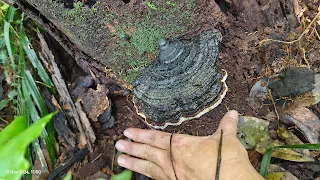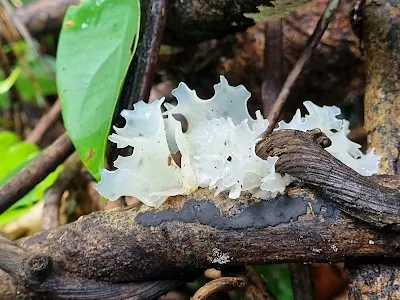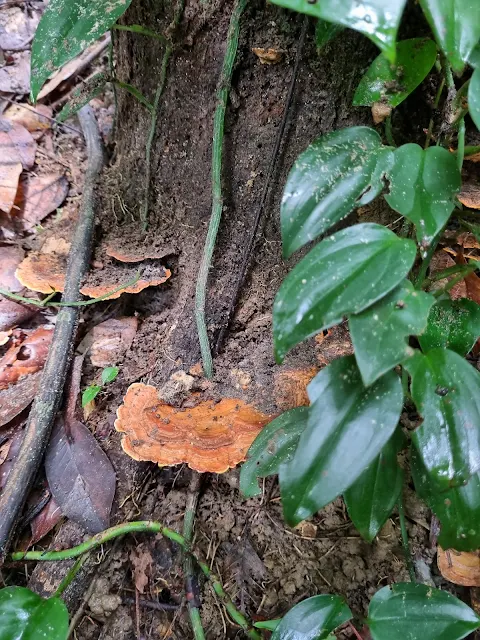Uncovering Hidden Diversity: A Collaborative Fungi Survey at Pulai Trail
Received: 9 December 2024 / Accepted: 22
Feb 2025
pulai@freetreesociety.org
Abstract Fungi are of great importance in both ecology and economy. A mycological survey was conducted at Pulai Trail Community Forest to document its fungi diversity on the 17th and 24th of November 2024 by a group of experts and enthusiasts organized by the Malaysian Nature Society Selangor Branch Mycology Special Interest Group (MNSSB Mycology SIG) and the Free Tree Society. The observations were uploaded and documented to the iNaturalist platform, namely the Pulai Trail MycoBlitz project. The data showed that the fungi and other species found could benefit local communities that call Pulai Trail home when more comprehensive studies are conducted.
Introduction
Pulai Trail Community
Forest (Pulai Trail) is 6 hectares of forested wilderness in Bukit Persekutuan,
Kuala Lumpur. It is one of the last remaining green spaces in the metropolis,
hidden with biodiversity waiting to be explored. To date, there is no comprehensive
mycological survey in the area, and therefore, its fungi diversity is yet to be
known.
On November 17th and
24th, 2024, the Malaysian Nature Society Selangor Branch Mycology Special
Interest Group (MNSSB Mycology Group) conducted a two-day fungi survey at the
forest with trail guidance from the Free Tree Society. The survey was led by
Loon Yit Hong and five members that consisted of fungi enthusiasts and citizen
scientists. The team explored the main access trails, Pulai Loop 1 and 2
Trails, which covered a total distance of 1.2 kilometers.
The survey aims to document the fungal diversity in the forest and understand its ecology and economic value, which may benefit local communities in Bukit Persekutuan.

Pulai Trail Mycology Survey Team: MNSSB Mycology Group Leader Loon Yit Hong (2nd from the right),
President of the Free Tree Society, Madam Carolyn Lau (3rd from the right) and volunteers.
Material
and Method
Survey Area and Data Collection
The survey area was
conducted along the main access trails, Pulai Loop 1 and Pulai Loop 2. The
two-day survey was conducted on November 17th and 24th, 2024, for two
consecutive weeks during the wet rainy season in Selangor, Peninsular Malaysia.
Information about the fungi (including identification, photos, coordinates, size measurements, description, and ecology) was documented and uploaded to the iNaturalist platform, namely the Pulai Trail Mycoblitz project. Further accurate identification is verified by mycologist1 and expert2.
Results
and Discussions
Despite surveying the
area in a limited period of time, we made 172 observations and confidently
recorded 54 different species of fungi, with more still to be identified.

Pulai Trail Survey Map with observations indicated in the iNaturalist project, Pulai Trail Mycoblitz.
Before our survey,
Pulai Trail had only 43 observations of fungi on the iNaturalist platform (https://www.inaturalist.org/projects/pulai-trail-mycoblitz),
representing 18 species from 13 observers. Thanks to our group’s efforts, this
number has now grown to 203 observations and 51 species (with many more still
to be uploaded). The findings from this survey provide a snapshot of the incredible
fungal diversity at Pulai Trail.
Survey Summary: 172 observations with
50 species of Fungi and 4 species of Protozoans are recorded.
Recorded Families, Genera, and Species
Our findings encompass a wide range of fungal families and genera as summarized in the following table.
Survey Summary: List of Recorded
Families, Orders, Genera, and Species.
Ethnomycology of Pulai Trail Fungi
Ethnomycology bridges
cultural practices and the ecological significance of fungi, illustrating their
roles in local traditions, cuisine, and medicine. Below, we explore the
cultural and ethnomycological relevance of key fungi identified during the
Pulai Trail survey.
Trichaleurina javanica (Elephant’s Foot)
In different parts of
Malaysia, it carries a variety of local names. In Sabah, it is referred to as
"Mata Rusa" (deer eyes) by the Dusun people, while in Sarawak, it is
known as "Mata Kerbau" (buffalo eyes). It is not only culturally significant
but also valued as a marketable species, where it is consumed and prized for
its unique texture and potential health benefits.
In Madagascar, T. javanica is known among the
Betsimisarakas people as "Ranomatonantibary," meaning "tears of
an old woman." The copious gel produced by this fungus has been
traditionally used to treat ophthalmia (inflammation of the eyes), showcasing
its ethnomedicinal significance (Iturriaga et al., 2021).
The diversity of names
and uses for T. javanica highlights
its cultural importance across regions. While it is not widely consumed in all
areas where it is found, its unique appearance, market value, and potential
health benefits suggest it has underexplored uses in both ethnomedicine and
mycological research. Its distribution and traditional applications make it a
notable species for further study, both for its ecological role and its
cultural value.
Schizophyllum commune (Splitgill Mushroom / Kulat Sisir)
● Cultural Importance: Schizophyllum commune is a cornerstone of Malaysian ethnomycology.
Known as "kulat sisir" (comb fungus), it is recognized for its
medicinal and culinary uses among various indigenous communities. Indigenous
groups such as the Jakun in Johor and Temuan in Selangor use it to treat
respiratory conditions and for its anti-aging properties (Ayu et al., 2019; Foo
et al., 2018; Samsudin & Abdullah, 2019).
● Medicinal Properties: Modern studies reveal
that S. commune contains
polysaccharides with immune-modulating effects, offering potential in cancer
therapy. It is also studied for its antioxidant and anti-inflammatory
properties (Samsudin & Abdullah, 2019).
● Economic Value: The fungus has potential as a
sustainable, low-cost source of protein and micronutrients, comparable to
commercial mushrooms. It is occasionally sold in local markets and used in
soups and stir-fries (Ayu et al., 2019; Foo et al., 2018; Samsudin & Abdullah,
2019).
Schizophyllum
commune /
Splitgill Mushroom (Kulat Sisir)
(Photos by: Khor Hong Beng)
Cookeina spp. (Cup Fungus)
● Cup fungi such as Cookeina spp. are referred to as
"kulat mangkuk" (bowl fungus) and are occasionally collected for
their bright, colorful appearance or as minor culinary items. Villagers in
Sabah and Sarawak reportedly use related species as garnish or in soups
(Abdullah & Rusea, 2009; Foo et al., 2018).
● Ecological Note: This species typically grows
on decaying wood in moist environments, highlighting its role in nutrient
cycling within forest ecosystems (Abdullah & Rusea, 2009).
Cookeina spp. / Cup Fungus
(Photos by: Jacqueline Low and Loon
Yit Hong)
Microporus xanthopus
● Medicinal Uses: This vibrant bracket fungus is
valued for its anti-aging properties among indigenous communities. The Jakun
people have used it as a remedy for breast cancer and birth control. Its
traditional applications highlight the need for biochemical studies to validate
these uses (Ayu et al., 2019; Foo et al., 2018).
● Aesthetic and Decorative Use: Beyond medicine,
its bright yellow hues make it a potential candidate for ornamental or artistic
purposes (Foo et al., 2018).
Microporus xanthopus (Photos by: Loon Yit Hong)
Ganoderma spp.
● Medicinal Significance: Although not recorded
directly in the Pulai Trail survey, Ganoderma
spp., particularly Ganoderma lucidum
(lingzhi), is integral to Malaysian ethnomedicine. Used in powdered or
decoction forms, it is reputed for anti-cancer, anti-tumor, and immune-boosting
properties (Foo et al., 2018; Samsudin & Abdullah, 2019).
● Cultural Connection: Revered in Chinese and
indigenous Malaysian traditions, Ganoderma
represents longevity and health, often consumed as herbal tea or supplement
(Foo et al., 2018).
Ganoderma sp. (Photos by: Jacqueline Low)
Auricularia sp. (Wood Ear Mushrooms)
● Culinary Staple: Known as "kulat
korong" in Malaysia, Auricularia
spp. is widely consumed, often in soups or stir-fries. Its gelatinous
texture and mild flavor make it versatile in Malaysian cuisine (Foo et al.,
2018; Samsudin & Abdullah, 2019).
● Medicinal Benefits: Wood ear mushrooms are
traditionally used to treat hypertension and improve cardiovascular health.
They contain bioactive compounds that aid in blood thinning and cholesterol
reduction (Samsudin & Abdullah, 2019).
Auricularia sp. / Wood Ear Mushrooms
(Photos by: Jacqueline Low)
Xylaria sp.
●
Traditional Uses: Known for its tough, woody
texture, Xylaria sp. is not typically
consumed but is valued in indigenous folklore for its unique morphology, which
resembles burnt matchsticks (Samsudin & Abdullah, 2019).
●
Ecological Insights: As a saprobe, it
decomposes deadwood, enriching the soil and promoting forest regeneration
(Samsudin & Abdullah, 2019).
Xylaria sp.
(Photos by: Loon Yit Hong)
Termitomyces spp.
The
genus Termitomyces R. Heim is a paleotropical and edible mushroom classified
under the family Lyophyllaceae (Basidiomycota). The genus forms an obligate
symbiotic or mutualistic association with the fungus-feeding termites.
In
Malaysia, Termitomyces spp. is locally known as “Cendawan busut”, “Cendawan
melukut”, “Cendawan susu pelanduk”, “Cendawan anai-anai”, “Cendawan guruh”,
“Kulat tahun”, “Cendawan Tali” or “Kulat Tahun” (Change et. al. 2004, Azlina
et. al. 2012, 2013). Species that have been reported found in Peninsular
Malaysia: Termitomyces clypeatus, T.
entolomoides, T. heimii, T. eurhizus, T. microcarpus, T. aurantiacus, T.
radicatus and T. striatus.
(Pegler et. al., 1994, Turnbull et. al., 1999, Siddiquee et al. 2015).
Recently, a new species was discovered in Sabah (Jaya Seelan et al., 2020).
Termitomyces sp.
(Photos by: Loon Yit Hong)
Tremella fuciformis (Snow Fungus
/ White Jelly Fungus)
Tremella fuciformis, commonly known as Snow Fungus or White Jelly Fungus, is reportedly consumed by the Sabah indigenous population. It is locally called “Kulat Jeli putih.” The information on culinary and wild mushroom practices was mostly received from elderly people and passed on to the younger generations (Foo et al., 2018).
It is one of the most studied mushrooms that are reported to have medicinal properties such as skin nourishment, anti-aging, cholesterol-lowering, neurological protection (Shahrajabian et al., 2017), anti-inflammatory (Sassy & Kwanchanok, 2024), and more.
The mushroom is also used in pharmaceutical and cosmetic applications (Sasikala et al., 2023). The researcher concluded that its extract is a potential candidate for skin whitening formulations and warrants further studies. This formulation is a safer alternative to synthetic whitening formulations due to the usage of fully natural ingredients.
Tremella
fuciformis (Snow
Fungus / White Jelly Fungus)
(Photos by: Loon Yit Hong)
Pathogenic and Parasitic Fungi of Pulai Trail
Fungi
Rigidoporus microporus
Rigidoporus microporus is a well-known fungal pathogen, causing white root disease on more
than 100 different tree species. The greatest loss caused by this pathogen was
recorded in rubber tree (Hevea
brasiliensis) plantations (Nandris et al., 1987). Pulai Trail is a former
rubber tree plantation and it is unsurprising to find the pathogenic fungi
during the survey. However, it is unknown if the disease started to infect
other non-rubber trees and caused harm to them. It is alarming that we have
found the pathogen is infecting some young trees on our survey.
It
is suggested that forestry experts do a more comprehensive survey to assess the
risk of tree mortality from the pathogenic diseases at Pulai Trail.
Rigidoporus
microporus on
an unknown tree host at Pulai Trail.
(Photos by: Loon Yit Hong)
Rigidoporus
microporus on
a young unknown tree host at Pulai Trail.
Risk assessment is required to
evaluate the pathogen infections on trees at the forest. (Photos by: Loon Yit Hong)
Spinellus fusiger (Bonnet Mold)
Spinellus fusiger is the most common and widespread of the parasitic fungi seen on Mycena (Bonnet mushrooms) found on
decaying wood or leaf litter in moist forests. The genus Mycena and many small
mushrooms with fragile caps and slender stems are perfect hosts for Spinellus fusiger, which exploits the
mushroom’s surface as a base for its reproductive structures (Patrick 2024).
This
parasitic relationship is fascinating because Spinellus does not typically kill the Mycena mushroom. Instead, it uses the mushroom as a stable surface
and nutrient source for producing its own spores. The Spinellus hyphae (fungal threads) penetrate the mushroom’s outer
tissue, drawing nutrients from it, and then grow into the characteristic
sporangia-bearing filaments that cover the mushroom cap and stem (Patrick
2024).
As
a result, the mushroom becomes a vessel for Spinellus
fusiger’s reproductive process, continuing its lifecycle by dispersing
spores across the forest floor, where they might land on other mushrooms and
begin the cycle again. While the Mycena
mushroom may appear decomposed or weakened by this interaction, it often
survives the parasitism long enough to complete its own reproductive cycle,
spreading its own spores as well (Patrick 2024).
Spinellus
fusiger on a Mycena sp. mushroom.
(Photos by: Loon Yit Hong)
Entomophthorales (Insect Destroyer)
The
Entomophthorales (Insect Destroyer)
are an order of mainly entomogenous fungi. They are usually associated with Diptera, although some are pathogens of
other arthropods, nematodes, and tardigrades, amongst others (Kirk & Voigt,
2014).
The
typical life cycle of the entomopathogenic species of Entomophthorales involves the invasion of the host by germ hyphae
produced by adhesive spores (conidia), which are airborne. The fungus invades
the abdomen of the host. Following its death, sporophores are produced,
typically between the individual segments of the abdomen, where a new crop of
forcibly discharged spores is produced. Resting bodies are often produced
within the host, and the primary conidia also have the ability to produce
typically smaller secondary conidia, usually of the same form or as
morphologically distinct microconidia (Kirk & Voigt, 2014).
Entomophthorales are studied as a potential biological control of pest insects in
agriculture (Barta & Cagáň, 2006). They are valuable agents to control the
specific insect population as most of the species are closely host-specific,
and they pose no threat to non-target organisms.
Entomophthorales on an ant host. (Photos by: Loon Yit Hong)
Ectomycorrhizal Fungi of Pulai Trail
Ectomycorrhizal fungi are a type of fungi that form a symbiotic
relationship with the roots of various plant species. This relationship is
important for the ecosystem because it helps plants absorb water and nutrients,
and the fungi obtain carbohydrates in return.
It is surprising that almost all the fungi found are ascomycetes
and basidiomycetes that are saprophytic and parasitic. These include
decomposers that grow on fallen trees, branches, and leaf litter. The largest
group of fungi that play an important role in organic matter decomposition and
nutrition recycling.
The ectomycorrhizal fungi that are not spotted in our survey could
be due to not entering their fruiting season yet. A long-term six-year study by
Lee et al. 2002 suggested that the fruiting peak season of the mycorrhizae is
in February-March and August-September. It could also be because the forest was
a former rubber plantation estate where the mycorrhizae required a longer time
period to establish.
This fact requires further study by our team.
Conclusions
Acknowledgement
Loon Yit Hong (Event Organizer and MNSSB Lead
Coordinator)
Carolyn Lau (President and General Manager of Free Tree Society)
1Luca Pilia
(Mycologist)
2Joseph
Pallante (Amateur Mycologist)
Malaysian Nature Society Selangor Branch (MNSSB)
Event volunteers: Jacqueline Low, Lenny Wong, Kho Wui Kiong, Khor Hong Beng,
and Chan Chee Keong.
Sponsor
Project Titled: “RUGS, Pulai Trail: Advocacy and Capacity Building for Urban Forest Protection”.
References
●
Abdullah, F., & Rusea, G.
(2009). Documentation of inherited knowledge on wild edible fungi from
Malaysia. Blumea - Biodiversity Evolution and Biogeography of Plants
54(1):35-38 DOI:10.3767/000651909X475996.
●
Ayu, K. K., et al. (2019).
Documentation of macrofungi traditionally used by Jakun people in Johor,
Malaysia. August 2019IOP Conference Series Earth and Environmental Science
269(1):012013. DOI:10.1088/1755-1315/269/1/012013.
●
Azliza MA, Ong HC, Vikineswary S,
et al. (2012). Ethnomedicinal resources used by the Temuan in Ulu Kuang
Village. Ethno-Med. 2012;6(1):17–22.
●
Azliza MA. (2013). A comparison of
ethnobiological knowledge between the Mah Meri and Temuan tribes in Selangor
[master’s thesis]. Kuala Lumpur: University of Malaya.
●
Chang YS, Lee SS. (2004).
Utilisation of macrofungi in Malaysia. Fungal Divers. 2004; 15:15–22.
●
Foo, S. F., et al. (2018).
Distribution and ethnomycological knowledge of wild edible mushrooms in Sabah.
Journal of Tropical Biology & Conservation (JTBC) 15: 203–222:203–222.
DOI:10.51200/jtbc.v15i0.1494.
●
Iturriaga, T., et al. (2021).
First collection of the asexual state of Trichaleurina javanica from nature and the placement of Kumanasamuha. Asian Journal of Mycology 4(1): 19–28. DOI:10.5943/ajom/4/1/3.
●
Jaya Seelan et al. (2020) New
Species of Termitomyces (Lyophyllaceae, Basidiomycota) from Sabah (Northern
Borneo), Malaysia. Mycobiology March 202048(9):1-9.
DOI:10.1080/12298093.2020.1738743
●
Lee SS, Watling & Noraini
Sikin. (2002). Ectomycorrhizal basidiomata fruiting in lowland rain forests of
Peninsular Malaysia. Bois et Forêts des
Tropiques 274: 33–43
●
Marek Barta & Ľudovít Cagáň.
(2006). Aphid-pathogenic Entomophthorales (their taxonomy, biology and
ecology). Biologia 61(Suppl 21):S543-S616. DOI:10.2478/s11756-007-0100-x
●
Mohamad Hesam Shahrajabian et. al.
(2017). Chemical compounds and health benefits of Tremella, a valued mushroom
as both cuisine and medicine in ancient China and modern era. Amazonian Journal
of Plant Research 4(3):692-697. DOI:10.26545/ajpr.2020.b00077x
●
Nandris, D.; Nicole, M.; Geiger,
J.P. (1987) Root rot diseases of rubber trees. Plant Dis. 71, 298–306.
●
Patrick Pol. (2024) Spinellus
Fusiger on Mycena: parasites on the forest floor. Take Me North Blog. Oct 29,
2024. URL:https://www.takemenorth.com/blog/spinellus-fusiger/
●
Pegler DN, Vanhaecke M. (1994).
Termitomyces of Southeast Asia. Biology, Environmental Science. Kew Bulletin. DOI:10.2307/4118066.
●
Paul M Kirk & Kerstin Voigt.
(2014). Fungi: Classification of Zygomycetes: Reappraisal as Coherent Class
Based on a Comparison between Traditional versus Molecular Systematics.
Encyclopedia of Food Microbiology, 54–67. DOI:10.1016/B978-0-12-384730-0.00136-1.
●
Samsudin, N. I. P., &
Abdullah, N. (2019). Edible mushrooms from Malaysia: A literature review on
their nutritional and medicinal properties. International Food Research Journal
26(1): 11 – 31.
●
Turnbull E, Watling R. (1999).
Some records of Termitomyces from old world rainforests. Kew Bulletin Vol. 54,
No. 3, pp. 731-738.
●
Sasikala et al. (2023) Formulation
and Development of Tremella Fuciformis Whitening Gel. Current Trends in
Biotechnology and Pharmacy, Vol. 17 No. 4A (Supplement). DOI:
https://doi.org/10.5530/ctbp.2023.4s.94.
●
Sassy Bhawamai and Kwanchanok
Hunthayung (2024). Anti-inflammatory effects of snow mushroom (Tremella
fuciformis) drinks with different types of natural sweeteners on RAW 264.7
macrophages stimulated with lipopolysaccharide. Agriculture and Natural Resources
058(3):295-302. DOI:10.34044/j.anres.2024.58.3.01
●
Siddiquee S, Rovina K, Naher L, et
al. (2015). Phylogenetic relationships of Termitomyces aurantiacus inferred
from internal transcribed spacers DNA sequences. Advances in Bioscience and
Biotechnology, Vol.6 No.5, DOI: 10.4236/abb.2015.65035.








.jpg)











.jpeg)
.jpeg)


.jpeg)
.jpeg)









Comments
Post a Comment